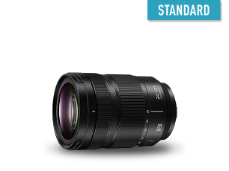

Olivier Anrigo is a French photojournalist, who has worked for news agencies like Thomson Reuters and EPA. He still works for AP (Associated Press). Besides news agencies, over the years he has expanded his clientele with brands and institutions. Just recently he was one of the almost 400 photographers to cover the Cannes Film Festival. With so much competition, it’s hard to stand out from the crowd and make sure you get the photos you want. ‘Working as a photojournalist for years taught me to approach a subject from different angles. Observation is key.’ He took the LUMIX S1 and S1R with him to Cannes.
For Olivier the Cannes Film Festival is a unique and special event. ‘The schedule is very busy with morning photo calls, conferences during the day and evening events, so I have to be extremely well organised. It’s like a marathon. Anticipation and preparing properly are vital.’
Working at the festival means being able to immediately grab the right gear whenever you need it. From wide angle to extreme detail, you constantly have to choose what frame you’re going to use. For this trip he packed the LUMIX S1R and LUMIX S1, LUMIX 24-105mm f/4, LUMIX S PRO 70-200mm f/4, Leica 16-35mm and Leica 90-280mm. ’The best photographers are able to analyse each situation almost instantaneously, and make the right choices at the right time.
If I see details in a dress or accessory I use the 70-200mm. The 24-105mm allows me to make wide shots to portray the person or subject on the red carpet. That can either be a famous actor or actress, a stunning long dress, or a stylist pacing the carpet.’
With almost 400 photographers working in a small space, the red carpet can turn into a jungle quite quickly. ‘This is often the case with red carpet moments for blockbusters like Quentin Tarantino's film Once Upon a Time with Brad Pitt and Leonardo Di Caprio. Even if we’re at a fixed location, we’re always bending and contorting to find interesting angles, which can quite a challenge with two cameras dangling around your neck.’
The Cannes Film Festival is often synonymous with exuberance and extravagance. ‘This gives a photographer the opportunity to make clichés out of the ordinary. To a practiced eye it’s an event teeming with details, and that's what I love!’ He used the LUMIX S1 as well as the SR1 at the Festival. What are his impressions? ‘These cameras are very complementary. The S1R delivered impressive size files. Thanks to the sensitivity of the LUMIX S1, even in lower light conditions I could keep photographing without a flash. If needed, I could choose a higher ISO and still got large file sizes.’ But that doesn’t mean he didn’t use a flash at all: when he did he used the Profoto A1 flash on the LUMIX S1R.
‘Both renderings are very interesting and allow for different atmospheres and lighting. For example, weather permitting, every evening during the festival there were screenings at the beach, which have such a special atmosphere. In these kinds of settings I either used a tripod to shoot at slow shutter speeds or I worked handheld with a higher ISO.’
Olivier continues: ‘It’s very reassuring to work with such professional equipment. As a photographer, you can just feel the amount of energy, time and care that has been invested in these cameras by the Panasonic engineers. The cameras are easy to handle, the buttons are in the right place. The ergonomics are great!’
Great photos depend on making sure the focus is on the right place. With moving subjects on the carpet, making unexpected gestures and movements, that can be tricky.
‘That’s why I choose to work in the AFC (continuous) mode. I often changed the mode of focus points, however, between one spot, horizontal spot, and 225 focus points. They all worked very well.’
For this assignment, he used the LUMIX 24-105mm f/4 and LUMIX S PRO 70-200mm f/4 the most. ‘These complementary objectives are both of high quality, as can be seen from the sharpness of the images. Because of its wide focal plane, I was a bit concerned about using the LUMIX 24-105mm f/4, but my doubts were dispelled when I used it on my night report of the Qatar MotoGP last month.’
The photo of Winnie Harlow, the woman in the red dress is one of his favorites from Cannes. ‘Winnie is a 24-year-old Canadian model with vitiligo (a condition that causes skin depigmentation). The image of her in the red dress on the red carpet is very strong; she truly stands out from the crowd.’

Olivier Anrigo
French photographer Olivier Anrigo inherited his father’s passion for photography at a very young age. Working in the family firm, Olivier gradually acquired very specific knowledge of photographic materials and unique insights into the craft.
His meeting with the Reuters’ photographer Eric Gaillard marked a turning point in his career. Olivier joined the international press agency in Eric Gaillard’s team, and worked alongside the best photojournalists. He learned how to create successful documentary stories with responsiveness and method, and gradually developed his own style.
Passionate about nature and wildlife photography, Olivier decided to go on expeditions around the world (Africa, Europe, Arctic Circle) with the support of institutions such as Fondation Prince Albert II de Monaco and Fondation Nicolas Hulot.
Today, he continues to work as a photojournalist with international agencies such as EPA, l’Equipe, etc. He loves to share his knowledge, so he developed a project dear to his heart: photo safari sessions in Masai Mara National Reserve in Kenya and Tanzania.













